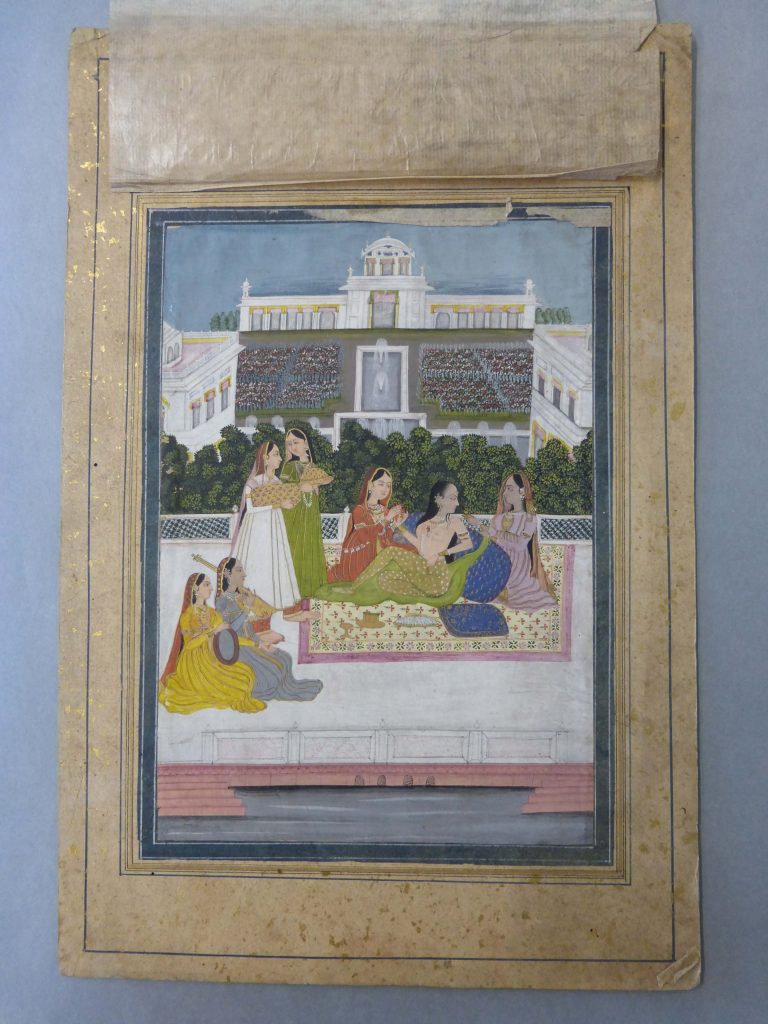In this week’s blog, Special Collections Conservator Emily, describes the first stage of conserving a collection of Indian portraits…
I was recently asked to complete a condition report and treatment proposal for a collection of 32 portraits from India, known as a Tasawir, dating from the late eighteenth or early nineteenth century. The images have been pasted onto gold-sprinkled paper, and 7 have examples of calligraphy on the back. They are due to be used in a teaching seminar at the University in the new academic year and are scheduled for exhibition in 2017, but need to be conserved and rehoused before they can be safely handled and displayed. Prior to any conservation work carried out on treasures in the collection such as this, a full condition report is required to document any signs deterioration. This allows the conservator to study the object in detail to understand the materials used, the types of damage found and what may have caused it, ensuring that the treatment proposal put forward is carefully considered and suitable for the item. The brilliance of the pigments used, and the detailed nature of the paintings make these items visually stunning and I was delighted to be given the opportunity to examine them closely.

One of the paintings in the Tasawir
The first step of creating a condition report is to identify the materials used to create the item. Indian artists used organic and inorganic pigments to create vibrant and rich paintings filled with colour. Indian artists typically used brushes made from natural animal hairs such as squirrel or goat, however the finest brushes were made from hair cut from two month old kittens! This allowed them to paint extremely fine details into their artwork. In the image below, you can see a man sitting on an elephant delicately painted in the background.

Fine detail of a man on top of an elephant found at the top left edge of this painting
The next step is to document the types of damage visible, and consider how it was caused. The paintings are in good condition overall, however each painting has a moderate amount of surface dirt, which has become ingrained at the corners and edges. This was probably caused by previous poor storage conditions.

Ingrained surface dirt found at the corners of the paintings
Many paintings also exhibit insect damage. The damage shown in the image below is likely to have been caused by the larvae of a woodworm.

Small holes caused by insects
Damage to the corners and the edges of the paper has also occurred. The paper support is formed of many layers of thin Islamic paper that have been adhered together. Over time these layers have become delaminated due to inappropriate handling and storage.

Delamination of the paper support at edges and corners
Islamic paper was often surface sized with starch and then highly burnished to create a smooth surface to draw and paint on. This smoothness can be problematic for some pigments, as they cannot attach easily to the paper leading to flaking of the paint layer, which is evident in some of the paintings in the Tasawir.

Flaking of the paint layer
Finally, tissue papers have been adhered to the top edge of some paintings. These tissue papers were intended to protect the item from dust and light, but they have discoloured with age, and of course obscure the images.

Tissue paper adhered to the top edge of the artwork
Also included in the condition report are photographs of each side of the paintings with details of any damage highlighted. This provides a visual map of the conservation issues associated with the item.
Find out how we conserve these paintings in part two of this blog.
Emily Hick
Special Collections Conservator

Pingback: A Passage to India – Part 2 | To Protect and (Con)serve
Pingback: Conservation Placement – Northumbria University | To Protect and (Con)serve